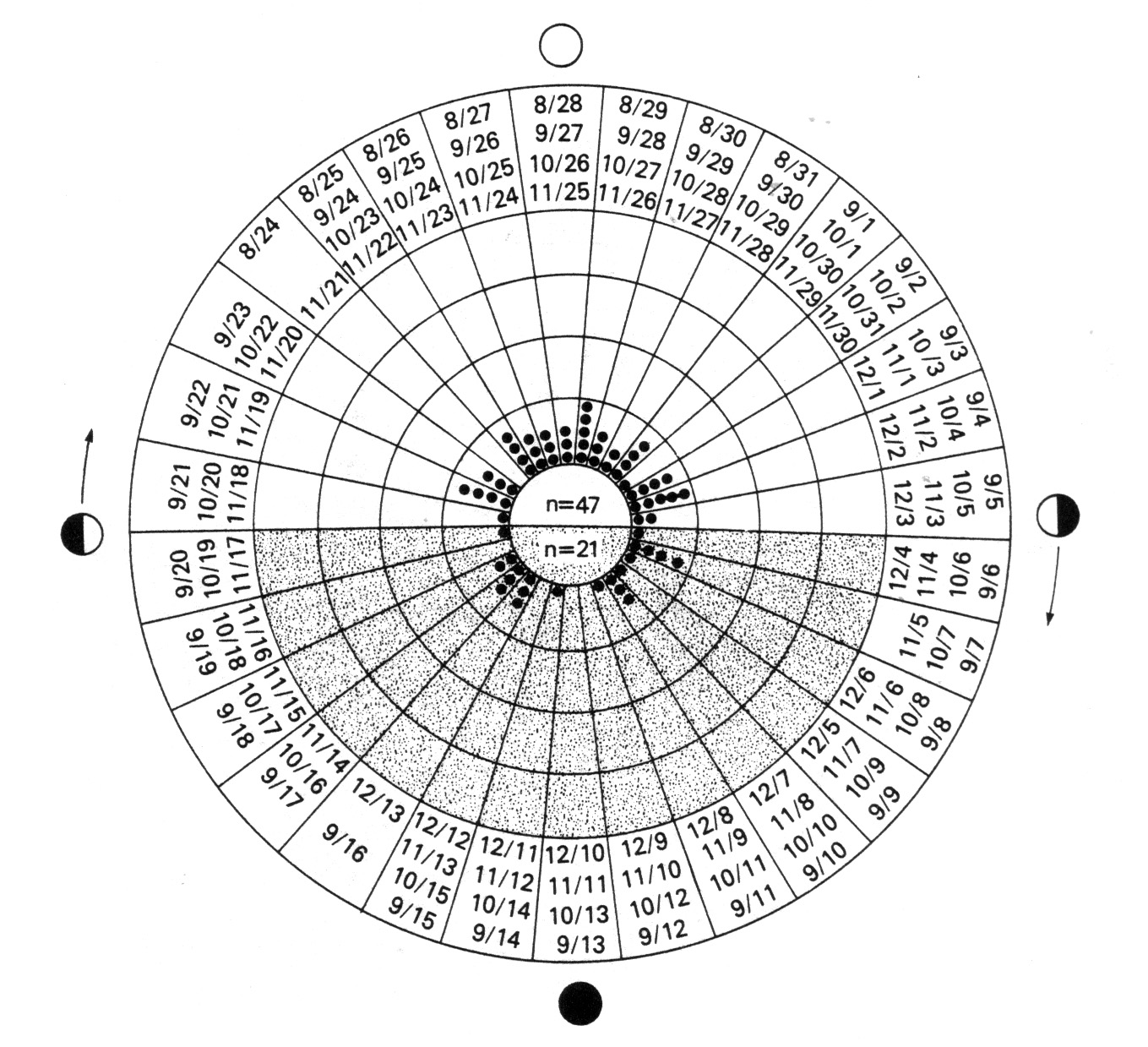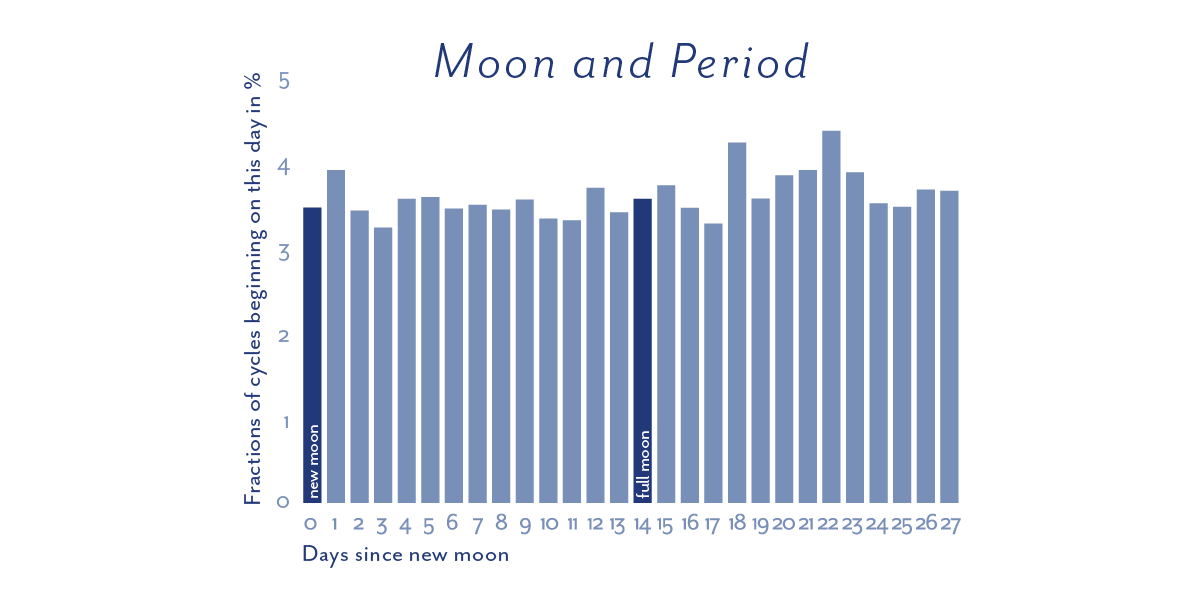Rory
Closed Account
An old and persistent myth is that the lunar cycle and the human menstrual cycle are (or should be) connected and synchronised. While many studies have shown this idea to be erroneous, others have appeared to support it. One of the most commonly cited is the study produced by Winnifred B. Cutler, PhD in 1980.
In the autumn of 1977, Cutler selected 312 college students (aged 19 to 22) who recorded their menstrual cycles over a 14-week period. Of these 312, 68 (21.8%) were reported as showing "a mean cycle length of 29.5 days, plus or minus 1 day", and these were the subjects Cutler focused on. She noted that "47 (69.1%) menstruated in the light half of the month" and 21 (30.9%) in the dark half. This was seen as statistically significant (z=3.16, p<0.001).
A pilot study carried out the previous year yielded similar results: 29 (22.8%) of 127 subjects showed a mean cycle of 29.5 days, ± 1 day, and of these 29, 22 (75.9%) menstruated in the light half of the month.
Cutler concluded that:
Now, the first thing to note is that Cutler's results neither claimed nor showed any evidence of an explicit synchronisation with a particular day of the lunar cycle, but rather a tendency among her subjects to menstruate during the 16-day period between the first and third quarters. Results were presented as follows:

Really, the study falls apart for three main reasons:
1. Her sample size is tiny. Even allowing for the extremely selective use of her subjects' data, 68 participants is nowhere near enough to draw a conclusion
2. Data is cherry picked, the analysis is poorly executed, and it's apparently biased towards a predetermined outcome. There are quite a few examples of this, which I'll detail in the post below.
3. Most conclusively, larger scale analyses have shown no tendency towards any hint of a pattern. For example, in 2016 tracker app Clue analysed 7.5 million menstrual cycles submitted by 1.5 million users and concluded there was:

Source: https://helloclue.com/articles/cycle-a-z/myth-moon-phases-menstruation
Interestingly, they also note that "the global average menstrual cycle length is 29 days", as opposed to the commonly held belief of 28 days, and that "Statistically speaking, with a random distribution of period start dates, about 1 in 2 women will have their period start ±3 days from either the full or new moon" - which may go some way to explaining why some still feel there is validity in the notion of a connection between the menstrual cycle and the moon.
In the autumn of 1977, Cutler selected 312 college students (aged 19 to 22) who recorded their menstrual cycles over a 14-week period. Of these 312, 68 (21.8%) were reported as showing "a mean cycle length of 29.5 days, plus or minus 1 day", and these were the subjects Cutler focused on. She noted that "47 (69.1%) menstruated in the light half of the month" and 21 (30.9%) in the dark half. This was seen as statistically significant (z=3.16, p<0.001).
A pilot study carried out the previous year yielded similar results: 29 (22.8%) of 127 subjects showed a mean cycle of 29.5 days, ± 1 day, and of these 29, 22 (75.9%) menstruated in the light half of the month.
Cutler concluded that:
She also stated that:"Menstrual cycles similar in length to the lunar cycle in these selected populations [...] tended to occur during the light half-cycle of the lunar period. Thus, ovulation is occurring in the new-moon part of the cycle and is coincident with the greatest gravitational pull on earth."
Source: https://www.athenainstitute.com/sciencelinks/lunarandmenst.html"Since the average lunar cycle is 29.5 days and the average menstrual cycle is also 29.5 days, the many conjectures of a lunar menstrual relationship [...] did make sense."
Now, the first thing to note is that Cutler's results neither claimed nor showed any evidence of an explicit synchronisation with a particular day of the lunar cycle, but rather a tendency among her subjects to menstruate during the 16-day period between the first and third quarters. Results were presented as follows:

Really, the study falls apart for three main reasons:
1. Her sample size is tiny. Even allowing for the extremely selective use of her subjects' data, 68 participants is nowhere near enough to draw a conclusion
2. Data is cherry picked, the analysis is poorly executed, and it's apparently biased towards a predetermined outcome. There are quite a few examples of this, which I'll detail in the post below.
3. Most conclusively, larger scale analyses have shown no tendency towards any hint of a pattern. For example, in 2016 tracker app Clue analysed 7.5 million menstrual cycles submitted by 1.5 million users and concluded there was:
"no correlation between the lunar phases and the menstrual cycle or period start date. Period start dates fall randomly throughout the month, regardless of the lunar phase".

Source: https://helloclue.com/articles/cycle-a-z/myth-moon-phases-menstruation
Interestingly, they also note that "the global average menstrual cycle length is 29 days", as opposed to the commonly held belief of 28 days, and that "Statistically speaking, with a random distribution of period start dates, about 1 in 2 women will have their period start ±3 days from either the full or new moon" - which may go some way to explaining why some still feel there is validity in the notion of a connection between the menstrual cycle and the moon.
Last edited:
